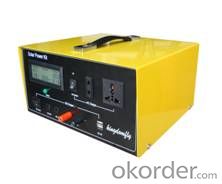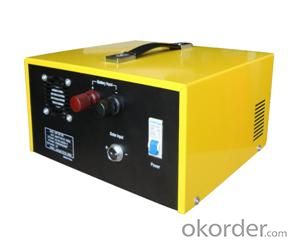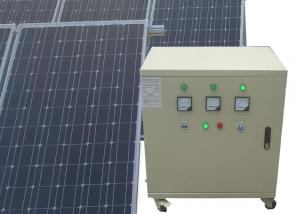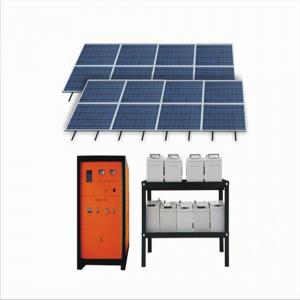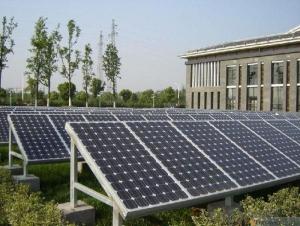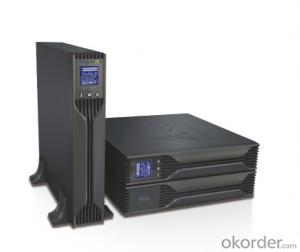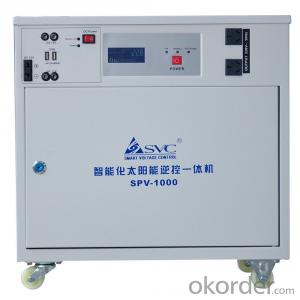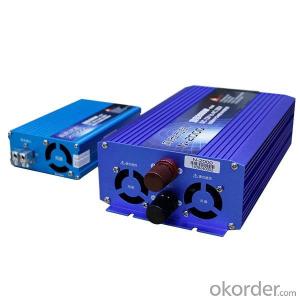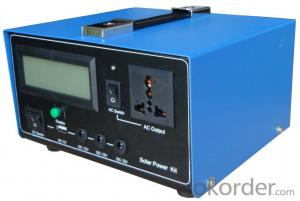Solar Energy Systems of Brevard Inc - SPK-500 Solar Power System for Home
- Loading Port:
- China main port
- Payment Terms:
- TT OR LC
- Min Order Qty:
- 3 pc
- Supply Capability:
- 10000 pc/month
OKorder Service Pledge
OKorder Financial Service
You Might Also Like
Main Information
KDF SPK_500 This product is high performance,family used portable solar power system,which can receive energy and store it in battery outside connected to SPK by solar energy on sunny day,and supplies electric power for varies appliances such as electric fan,lighting lamps, television, portable computer etc.It can supply power for both DC and AC electric application .It’s very helpful and useful for home electric supply.
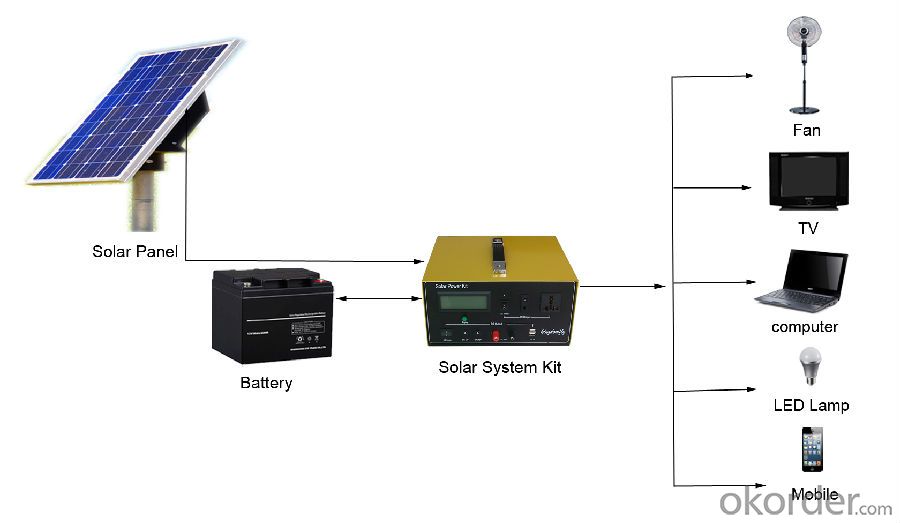
Features:
◆ Battery puts outside connected to the SPK for user to choose battery in recommended range, and easily to exchange battery.
◆ Both DC and AC output
◆ Solar Feedback Circuit Protection
◆ Output Short-circuit Protection
◆ Solar「+」「-」anti-access protection
◆ Output「+」「-」anti-access protection
◆ Over Charged Protection
◆ Over Discharged Protection
◆ Over Load Protection
◆ Over-Temperature Protection
Technical parameters
Specification | Value/Material | |
Item No. KDF | SPK_500 | |
Solar Recommended | Specification | Poly silicon |
Working Voltage/Power | 18V50W~300W | |
Battery Recommended | Rated Voltage/Capacity | 12V40AH~200AH |
Cycle Number | 80% Deep Cycle Number:500 70% Cycle Number:800 | |
Working Temperature | Short Period(one Month):-20~50℃ Long Period(Six Months):-10~45℃ | |
Charging Controller | Operating Voltage | 12V |
Input Voltage | 17.3V~21V | |
Input current | MAX:10A | |
Power Consumption | MAX: 5mA | |
Low Voltage Disconnect(LVD) | 10.8V | |
Low Voltage Reconnect(LVR) | 12.3V | |
High Voltage Discharge( HVC) | 14.6V | |
High Voltage Recharge(HVR) | 13.8V | |
Temperature Protection | 60℃ | |
DC Output | DC output & Application | USB 5V2A |
DC output & Application | DC 12V1*3A | |
AC Output | Output Wave | modified sine wave |
Input Voltage | 11V~15V | |
Output Voltage | 110V±10% | |
Output Frequency | 60Hz±2Hz/50Hz±2Hz | |
Rated Output Power | 300W | |
Maximum VA | 600VA | |
Maximum Efficiency | 88% | |
Temperature | 0-40℃ | |
Over Temperature | 60℃~70℃ | |
Low Voltage Alarm | 11V | |
Low Voltage Shut off | 10.5V | |
High Voltage Shut off | 16V | |
Package | Set size | 331*338*217mm |
Set N·W | 3.8kg | |
Set N·W | 4.6kg | |
LCD_Display
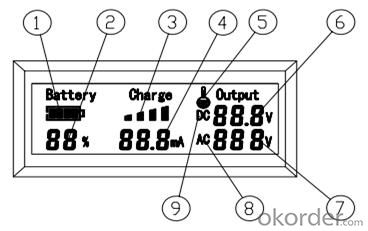
No. | Name | Function |
1 | Battery Icon | To show the Volume of the Battery |
2 | Date of % | To show the percent of the Battery |
3 | Charging Icon | To show the charging condition |
4 | Current | To show the value of charge current |
5 | Temperature Icon | Temperature Alarm |
6 | Date of Voltage | To Show the Value of DC output voltage |
7 | Date of Voltage | To Show the Value of AC output voltage |
8 | AC Icon | AC output |
9 | DC Icon | DC output |
- Q: How does solar energy compare to other renewable energy sources like wind or hydro power?
- Solar energy is a highly versatile and accessible renewable energy source that offers several advantages compared to wind or hydro power. While wind power relies on consistent wind patterns and hydro power requires access to water resources, solar energy can be harnessed virtually anywhere with sunlight. Solar panels are also easier to install and maintain compared to wind turbines or hydroelectric dams. Additionally, solar energy systems have a longer lifespan and produce less noise pollution compared to wind turbines. However, solar energy's efficiency is dependent on weather conditions and it may require larger land areas for installation, making it less suitable in areas with limited space or inconsistent sunlight. Ultimately, the choice between solar, wind, or hydro power depends on specific geographical and environmental factors.
- Q: What is the maintenance schedule for a solar energy system?
- The maintenance schedule for a solar energy system typically involves regular cleaning of the panels, checking for any damage or debris, and inspecting the system's overall performance at least once a year. Additionally, it is important to monitor and maintain the batteries, inverters, and other components as needed.
- Q: What happens to a solar energy system during a power outage?
- If a solar energy system is connected to the grid, it will typically cease generating electricity during a power outage. This is because grid-tied solar systems are designed to automatically shut down when the grid goes down in order to ensure the safety of workers repairing the power lines. Consequently, even if the sun is shining and the panels are capable of generating electricity, the system will not operate until grid power is restored. However, there are certain types of solar energy systems, such as off-grid or hybrid systems, that can continue generating electricity even during a power outage. Off-grid systems are designed to store excess solar energy in batteries, which can then be used to power the home or facility during periods of no sunlight or power outages. These systems are not connected to the grid and operate independently, offering a reliable power source even when the grid is down. On the other hand, hybrid systems are connected to the grid but also have the ability to store energy in batteries. In the event of a power outage, these systems can switch to battery power, allowing them to continue generating electricity and provide backup power to essential loads in the building. This provides a level of energy independence and resilience during emergencies or extended power outages. It is important to understand that the ability of a solar energy system to function during a power outage depends on the specific type of system installed and its configuration. Seeking guidance from a professional solar installer or system provider can help determine the most suitable system for individual needs and requirements.
- Q: How do solar energy systems impact job training and skill development?
- Solar energy systems have a positive impact on job training and skill development. As the demand for renewable energy continues to rise, the installation, maintenance, and operation of solar panels require specialized skills. This creates opportunities for job training programs and vocational schools to offer courses and certifications specifically tailored to the solar energy industry. Consequently, individuals can acquire valuable skills, such as solar panel installation, electrical engineering, and project management, which not only enhance their employability but also contribute to the growth of the clean energy sector. Overall, solar energy systems play a crucial role in expanding job training initiatives and skill development in the renewable energy field.
- Q: Can solar energy systems be used in areas prone to hurricanes or tornadoes?
- Yes, solar energy systems can be used in areas prone to hurricanes or tornadoes. While extreme weather events like hurricanes and tornadoes can potentially damage solar panels, advancements in technology and installation practices have made solar systems more resilient and able to withstand such conditions. For instance, solar panels are designed and tested to withstand high wind speeds and impact from debris. Additionally, proper installation techniques, such as using reinforced mounting systems and ensuring secure attachment to roofs or the ground, can further enhance their resistance. Therefore, while precautions need to be taken, solar energy systems can still be a viable and sustainable option in areas prone to hurricanes or tornadoes.
- Q: Can a solar energy system be installed on a warehouse or industrial facility?
- Certainly, it is possible to install a solar energy system on a warehouse or industrial facility. In fact, these types of structures are often ideal for solar installations due to their expansive roof areas and abundant exposure to sunlight. The installation of solar panels on a warehouse or industrial facility can assist in reducing energy expenses, reducing dependency on grid electricity, and contributing to a more sustainable and environmentally conscious operation. Moreover, solar energy systems can serve as a backup power source in the event of grid failures, ensuring uninterrupted operations in crucial industrial processes. With the advancements in solar technology and the availability of various financing options, the installation of solar energy systems on warehouses and industrial facilities has become increasingly practical and cost-efficient.
- Q: Can solar energy systems be used for powering electric vehicle component manufacturing plants?
- Certainly, electric vehicle component manufacturing plants can make use of solar energy systems. Solar power is an abundant and sustainable source of electricity that can effectively meet the energy requirements of various industrial processes. By installing solar panels on the roofs or open areas surrounding the manufacturing facility, the plant can produce clean and emission-free electricity, reducing its dependence on conventional energy sources. Solar energy systems have the capacity to generate a significant amount of electricity, particularly when combined with advanced technologies like concentrated solar power or solar tracking systems. These systems efficiently capture sunlight and convert it into electricity, providing a reliable and consistent power source for the manufacturing plant. Furthermore, electric vehicle component manufacturing plants often consume substantial energy for activities such as machining, welding, and assembly. By utilizing solar power, these plants can not only fulfill their electricity needs but also lower their operational expenses and environmental impact. Solar energy contributes to achieving sustainability objectives and facilitates a cleaner and more eco-friendly manufacturing process. Moreover, the adoption of solar energy systems in electric vehicle component manufacturing plants can serve as an effective marketing tool. As the demand for electric vehicles and sustainable manufacturing practices continues to grow, consumers are increasingly attracted to companies that actively promote renewable energy. By powering their manufacturing plants with solar energy, companies can demonstrate their commitment to environmental responsibility and appeal to environmentally conscious customers. In conclusion, solar energy systems can indeed be employed to power electric vehicle component manufacturing plants. With their ability to generate clean, reliable, and cost-effective electricity, solar power plays a crucial role in meeting the energy requirements of these plants while promoting sustainability and reducing environmental impact.
- Q: How do solar energy systems affect the grid?
- The grid can be affected both positively and negatively by solar energy systems. On the positive side, these systems can decrease the demand for electricity from traditional power plants, particularly during peak hours. This can alleviate strain on the grid and lessen the need for additional generation capacity. Furthermore, the decentralization of the grid can be facilitated by solar energy systems. Generating electricity at the point of use can reduce transmission and distribution losses, resulting in a more efficient energy system. Additionally, grid resilience can be enhanced as power can be produced locally, reducing vulnerability to disruptions in the transmission and distribution infrastructure. However, challenges can arise when it comes to solar energy systems and the grid. One of the main issues is intermittency, as solar energy generation depends on the availability of sunlight, which varies throughout the day and is absent at night. This can lead to fluctuations in the supply of electricity, necessitating the balancing of the system by grid operators to ensure a stable supply. To tackle this issue, energy storage systems, such as batteries, may need to be invested in by grid operators. These systems can store excess solar energy during peak production and release it during periods of low production, thereby smoothing out the intermittent nature of solar energy and improving grid stability. Additionally, the integration of large-scale solar energy systems into the grid may require significant upgrades to the transmission and distribution infrastructure. These upgrades are essential to accommodate the increased flow of electricity from distributed generation sources and guarantee the reliable and safe operation of the grid. In conclusion, solar energy systems can have a positive impact on the grid by reducing demand from traditional power plants and decentralizing the energy system. However, challenges related to intermittency and the need for grid upgrades must be addressed. Overall, with proper planning and investment, solar energy systems can play a crucial role in transitioning towards a more sustainable and resilient grid.
- Q: Are there any risks of electrical overloading with solar energy systems?
- Solar energy systems do pose certain risks of electrical overloading. One of the primary causes of overloading is when the capacity of the solar panels does not match the electrical load. If the panels generate more electricity than what is being consumed or stored, it can result in an overload within the system. Another risk arises from the need for inverters in solar energy systems. These inverters are responsible for converting the DC power generated by the panels into AC power that can be utilized in homes or businesses. However, inverters have their limits, and if the panels produce more electricity than the inverter can handle, overloading can occur. Furthermore, overloading can also be caused by wiring or connection issues. Insufficiently sized wiring or loose and faulty connections can increase resistance and lead to overheating, ultimately resulting in overloading. To mitigate these risks, it is crucial to accurately size the solar energy system to match the electrical load. This necessitates considering factors such as average energy consumption, peak energy demand, and the capacity of the inverter. Additionally, it is essential to hire certified professionals to ensure proper wiring and connections, which should be regularly inspected for signs of wear or damage. Moreover, the installation of safety mechanisms like circuit breakers and surge protectors is vital for preventing overloading and safeguarding the solar energy system against potential damage. Regular maintenance and monitoring of the system can also aid in early issue detection and prevention of overloading.
- Q: Can solar energy systems be used to power electric vehicles?
- Yes, solar energy systems can be used to power electric vehicles. Solar panels can be installed on the roof of a vehicle or in a stationary location to capture sunlight and convert it into electricity. This electricity can then be used to charge the batteries of electric vehicles, providing a clean and renewable source of energy for transportation.
Send your message to us
Solar Energy Systems of Brevard Inc - SPK-500 Solar Power System for Home
- Loading Port:
- China main port
- Payment Terms:
- TT OR LC
- Min Order Qty:
- 3 pc
- Supply Capability:
- 10000 pc/month
OKorder Service Pledge
OKorder Financial Service
Similar products
Hot products
Hot Searches
Related keywords



